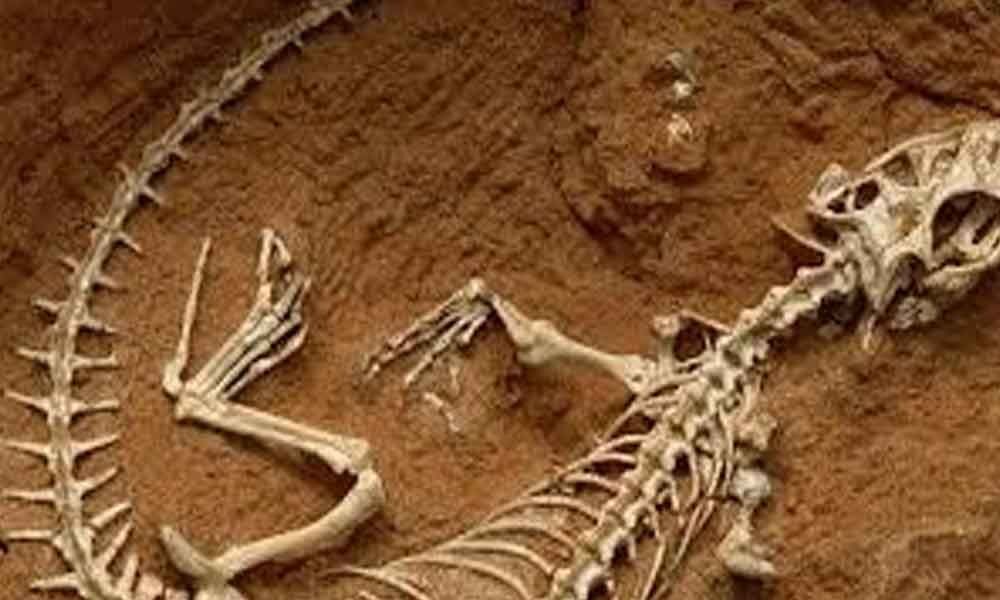Live
- Rajasthan HC quashes FIR against Shilpa Shetty under SC/ST Act
- Santosh Trophy 2024: Odisha grab big win against Madhya Pradesh
- Innovation programmes to come up at 1,000 campuses in Kerala
- Chelsea's James Reece to miss match against Leicester due to hamstring injury, confirms Maresca
- Aim to design Tirumala into a planned model town'-TTD EO
- Maha records 65.11 per cent polling, highest in three decades
- Have no trust in pre-poll surveys- DKS
- The Rana Daggubati Show at IFFI 2024, Redefining Celebrity Talk Shows
- TN govt to reject Tungsten mining proposal in Madurai district: Forest Minister
- Bhupesh Baghel threatens defamation case over allegations in Bitcoin scam
Just In

When animals or plants are rapidly buried in layers of mud during a natural catastrophe, their bodies are protected from normal processes of decay:...
When animals or plants are rapidly buried in layers of mud during a natural catastrophe, their bodies are protected from normal processes of decay: scavengers, bacteria, and chemicals are prevented from breaking down their bodies at the usual rate. The hard parts of the animals (such as their bones, teeth, and shells) are eventually replaced with minerals from the mud, which turn them into rock.
The soft parts of the specimen, such as the scales of a fish or the leaves of a plant, sometimes leave a colored imprint in rock before they eventually decay. Trees or other organic matter that are covered with silica-rich water become petrified—they turn into solid mineral. All of these methods result in what we know as fossils.
Fossils are most commonly found in limestone, shale, and sandstone, all relatively soft rock that erodes more easily than most rocks do. As the rock gradually wears away, the fossil layers within it are exposed.
One enjoyable way of demonstrating how fossils are made is to make fossil casts. Start with a clean tuna can or styrofoam bowl and fill it to a depth of about 1′ with modeling clay. Then press a plastic animal, rock, or other object halfway into the clay. Remove the object, leaving a clean imprint in the clay.
Next, mix 1/4 to 1/2 cup plaster of paris with water until the consistency is similar to pancake batter. Pour the plaster into the can over the clay, filling the imprint and covering the bottom of the can to a depth of about 1′. Let the plaster dry for at least 24 hours before removing it from the can. Separate any remaining clay from the plaster and you have a 'fossil' of the object.
A paleontologist is a scientist who studies fossils to find out more about extinct species or about any species that are evident in the fossil record.
Science Lesson: What Did Dinosaurs Look Like? What did dinosaurs look like? If you hear the word 'Stegosaurus', what picture immediately comes to mind? What about 'Tyrannosaurus'? 'Brontosaurus'? You've probably seen illustrations or models of many different dinosaurs: gigantic creatures with long necks and tails, stocky creatures with hard heads and horns or fierce teeth, and even swimming dinosaur-like creatures! But have you ever wondered what scientists really know about an extinct species? What they looked like? What they ate? How do scientists find out that sort of information?
Complete dinosaur skeletons are rare; usually a paleontologist has to piece together a fragmented skeleton and use the available parts to try to determine the way the full skeleton would look.
Sometimes, fossilized skeletons get put together wrong—the case of the Brontosaurus is an example of this. The Brontosaurus, perhaps the most famous dinosaur after the T. rex, is really an Apatosaurus, with the head of a Camarasaurus. However, the name Brontosaurus is still the most popular. Dinosaurs are a tricky thing to study, since the evidence about them is limited. It's easy to confuse where science ends and assumption begins—forming theories is part of a paleontologist's job, but theories should not be accepted as fact when based on insufficient evidence.

© 2024 Hyderabad Media House Limited/The Hans India. All rights reserved. Powered by hocalwire.com







